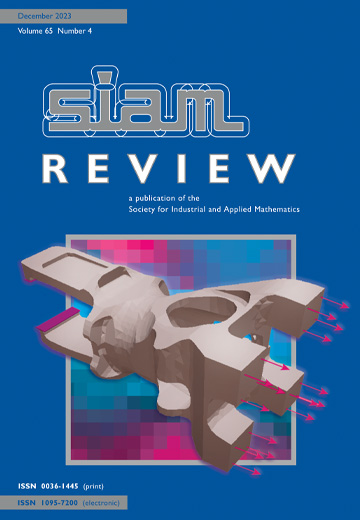带记忆的车厢型号
IF 6.1
1区 数学
Q1 MATHEMATICS, APPLIED
引用次数: 0
摘要
SIAM评论,第65卷第3期,第774-805页,2023年8月。隔间建模的美丽和简单使其成为模拟动力学的一种有用方法,应用范围非常广泛,尤其是在全球碳循环、水文网络流动、流行病学和人口动力学方面,应用范围迅速发展。然而,这些情况通常涉及隔间到隔间的流动,这与线性模型中导致指数停留时间的完全混合的传统假设不一致。在这里,我们详细介绍了一种通用方法,用于将任何所需的停留时间分布分配给给定的室间流,将室建模能力扩展到传输操作、幂律停留时间、扩散等,而无需使用复合室、分数微积分或偏微分方程(PDE)进行扩散传输。这是通过将质量交换率系数写成隔间中年龄的函数来实现的,正如1917年第一个隔间模型中所做的那样,代价是将通常的常微分方程转换为一阶偏微分方程组。偏微分方程很容易转换为一个积分方程组,为此设计了一种数值方法。示例计算表明,在隔间模型中引入了平流滞后、平流-分散输运、幂律停留时间分布或扩散域。本文章由计算机程序翻译,如有差异,请以英文原文为准。
Compartment Models with Memory
SIAM Review, Volume 65, Issue 3, Page 774-805, August 2023.
The beauty and simplicity of compartment modeling makes it a useful approach for simulating dynamics in an amazingly wide range of applications, which are growing rapidly especially in global carbon cycling, hydrological network flows, and epidemiology and population dynamics. These contexts, however, often involve compartment-to-compartment flows that are incongruent with the conventional assumption of complete mixing that results in exponential residence times in linear models. Here we detail a general method for assigning any desired residence time distribution to a given intercompartmental flow, extending compartment modeling capability to transport operations, power-law residence times, diffusions, etc., without resorting to composite compartments, fractional calculus, or partial differential equations (PDEs) for diffusive transport. This is achieved by writing the mass exchange rate coefficients as functions of age-in-compartment as done in one of the first compartment models in 1917, at the cost of converting the usual ordinary differential equations to a system of first-order PDEs. The PDEs are readily converted to a system of integral equations for which a numerical method is devised. Example calculations demonstrate incorporation of advective lags, advective-dispersive transport, power-law residence time distributions, or diffusive domains in compartment models.
The beauty and simplicity of compartment modeling makes it a useful approach for simulating dynamics in an amazingly wide range of applications, which are growing rapidly especially in global carbon cycling, hydrological network flows, and epidemiology and population dynamics. These contexts, however, often involve compartment-to-compartment flows that are incongruent with the conventional assumption of complete mixing that results in exponential residence times in linear models. Here we detail a general method for assigning any desired residence time distribution to a given intercompartmental flow, extending compartment modeling capability to transport operations, power-law residence times, diffusions, etc., without resorting to composite compartments, fractional calculus, or partial differential equations (PDEs) for diffusive transport. This is achieved by writing the mass exchange rate coefficients as functions of age-in-compartment as done in one of the first compartment models in 1917, at the cost of converting the usual ordinary differential equations to a system of first-order PDEs. The PDEs are readily converted to a system of integral equations for which a numerical method is devised. Example calculations demonstrate incorporation of advective lags, advective-dispersive transport, power-law residence time distributions, or diffusive domains in compartment models.
求助全文
通过发布文献求助,成功后即可免费获取论文全文。
去求助
来源期刊

SIAM Review
数学-应用数学
CiteScore
16.90
自引率
0.00%
发文量
50
期刊介绍:
Survey and Review feature papers that provide an integrative and current viewpoint on important topics in applied or computational mathematics and scientific computing. These papers aim to offer a comprehensive perspective on the subject matter.
Research Spotlights publish concise research papers in applied and computational mathematics that are of interest to a wide range of readers in SIAM Review. The papers in this section present innovative ideas that are clearly explained and motivated. They stand out from regular publications in specific SIAM journals due to their accessibility and potential for widespread and long-lasting influence.
 求助内容:
求助内容: 应助结果提醒方式:
应助结果提醒方式:


